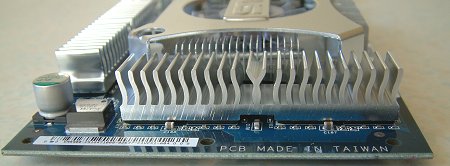EN5900 board examination

There's good reason for the card's strange-looking appearance. NVIDIA has been content, thus far, to release PCIe cards by bridging present AGP designs. That's exactly like it sounds; NVIDIA's using a physical bridging chip, clad by the left-hand heatsink, and its own HSI (High-Speed Interconnect) to mold GPUs to accept a PCIe form factor. NVIDIA has also realised that bridging still leaves the weaker link, AGP protocol, as the limiting factor in data transmission, both to and from the northbridge. NVIDIA steadfastly maintains that bridging on current GPUs doesn't have a noticeable impact on performance, so, on the whole, performance should be similar to AGP-equipped models.

Another by-product of having to locate a bridging chip on the PCB is increased space. Notice just how much room exists around the 5900 XT GPU and left-hand components. ASUS has deemed that a small-ish aluminium cooler and SmartDoctor-controlled fan is enough to keep the 375MHz-rated XT GPU core at reasonable temperature levels. Given a choice, I'd have preferred a larger, slower-spinning fan.

Wavy aluminium heatsinks make firm contact with the card's 128MB DDR1 RAM that runs at a nominal 700MHz and is fed through a 256-bit memory interface. Note the lack of an additional Molex connector. That's one of the benefits associated with midrange cards.

S-Video, HD15 and DVI connections grace the back panel. Much like motherboards, value can be added by using a discrete VIVO chip. That's exactly what ASUS has done here.

A look at the rear side also highlights an expansive PCB board that's largely filled with tracks leading from the bridge chip through to the 5900 XT GPU. The advantage of a bridge chip, according to NVIDIA, probably lies with the comparative ease of releasing PCIe cards. ATI, on the other hand, has chosen to run with a native PCIe design right from the off.

I alluded to VIVO earlier. Here's its physical manifestation, courtesy of a Philips multi-standard video capture ASIC. It's a cheap, useful addition to a midrange card.









